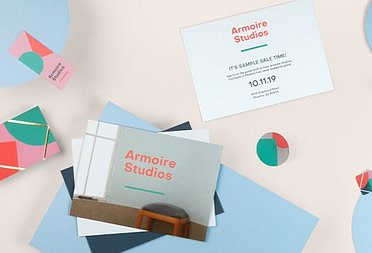The ultimate guide to client acquisition
Connect with new clients online and offline with 14 tips to get more clients.

Whether you’re self-employed or starting a company, client acquisition is a must-have skill. If you’re wondering how to find clients, you’re in the right place. We’ve put together 14 ideas to help you connect with new clients – and keep the ones you’ve got.
New business can come from all kinds of unexpected places, but to get regular work, you need to have a little more of a client acquisition strategy in place.
That’s especially true if you’re just starting a business. If you’re planning a transition from employment to self-employment, it’s never too early to get started. Side-projects and freelancing can help you develop a portfolio or collect a few glowing testimonials.
Your strategy for finding clients will depend somewhat on the kind of industry you’re in. For example, if you’re in real estate, networking might be your primary approach. As a designer, you might lean more towards online portfolio sites and social media to broadcast your talents. Whatever your specialty, these ideas will help you get more clients

How to find clients online
Here’s a few ways to drum up business in the world of digital communication to get clients.
1. Use freelancing sites
Many businesses get started by hitting freelancing networks like Upwork and Fiverr. These match-making services help you get your first clients based on their needs and your skills and can help you make connections you never would have found otherwise. It’s a great client acquisition strategy to build your network.
Prospective customers upload their jobs and choose an available freelancer who offers the best fit. It can be competitive, as there are many freelancers vying for jobs, and the sites will keep a percentage of what you get paid. But as a way to kick off your career and gain experience, it’s an avenue worth exploring.
2. Encourage referrals
If a client is happy with your work, encourage them to shout about it on their social channels and recommend you to their contacts. You can ask for direct referrals too – let them know you’re looking to build up your customer base and ask if they know any other businesses who could use your services.
Just make sure they know that even if you get more clients, you’ll still have time to give their jobs 100% of your attention. Getting referrals from existing clients is a great way to generate leads, as each lead comes primed with a trusted recommendation.

3. Explore your online network
Prospective customers are everywhere, and you probably already have a few in your online network. If you’re looking for tactics on how to find clients online, take some time to go through your list of LinkedIn contacts, Instagram followers and Facebook friends and draw up a list of prospective customers.
Look in less-obvious places too, such as your email address book and your phone contacts. Chances are there are a few people in there who might be relevant to your client search, so make some calls to see if your friends or contacts know of any new businesses who might need your services.
4. Ace your digital marketing
One of the many benefits of the internet is the fact that there’s a low barrier for getting in touch with people. Sometimes, it’s not so much finding clients as it is helping them find you.
Potential customers who see your digital marketing can easily drop you an email or reply to your post, sparking the beginning of a business relationship. So polish up your online presence and make sure there are strong calls to action on your website, social profiles and emails.
5. Introduce yourself
People love it when a solution finds them rather than vice versa. That’s why it’s worth hitting a few inboxes at companies you’d like to work for, even if they’re not actively recruiting for suppliers. LinkedIn is a great tool for this, as you can use it to research and target the right people, and automatically link them to your profile.
Cold emailing potential clients may not sound too appealing, but provided you’ve done your research and can make a well thought-out case for working together, it doesn’t have to be awkward. Focus on quality not quantity and try a few cold pitch emails. Each one should be unique and tailored to the business you’re approaching, maybe by mentioning your experience in their sector or suggesting a project based on what they do.
You could chance on somebody who’s been wanting some help but hasn’t yet got around to searching for it or make a connection that could lead to some work in the future.

6. Develop a case study ebook
One well-established way to drum up leads is by ‘gating’ a piece of content. Produce a high value download like an e-book and offer it to your audience in exchange for their contact details. They receive some useful insights, and you receive a list of people who are actively interested in the kind of work you do and some of whom may just turn into clients.
Why a case study? Well, it has the bonus of showing the benefits of working with your business. Try asking an existing client if they’d like to partner with you on an e-book, which you can each use to promote your service.
7. Be a problem-solver on social media
Social media is a great place to boost client acquisition and build your brand. To get your name known, be active on Quora and LinkedIn, and check Twitter and Facebook for questions you can answer.
This is a neat way to showcase your expertise to potential clients and earn a little karma at the same time. For best results, make sure your social profiles include a link to your website or online portfolio so it’s really easy for potential clients to find out more about you.
How to find clients offline
Here’s some ways to generate leads and get clients in real-world contexts.
8. Pitch in person
Think cold call, but in person. This technique is less common than it once was, which can help you stand out – you might even be the only supplier who has introduced yourself face to face with a potential client.
To avoid potential awkwardness, frame your cold pitch in person as a casual thing, using phrases like ‘I was in the neighborhood’ or ‘I had some free time and wanted to introduce myself’. Suggest a meeting for longer at a later date and leave them your Business Card.

9. Join a co-working space
If you’re wondering how to get clients, consider joining a co-working space. Co-working spaces are fertile ground for all sorts of business opportunities, not least finding clients. You’ll get to know the other members, and you’re highly likely to either find a new client or be referred to one.
You may also find ways to collaborate with other co-working members on joint projects that combine your skills and theirs.
10. Attend a trade show
That’s “how to get clients” 101. Grab your trusty Business Cards and a stack of Flyers and get on the events circuit in your area. You can find listings for events online, using sites like Eventbrite and Expodatabase, or follow the trail on Twitter and Instagram using hashtags like #tradeshows, #eventmarketing and #exhibitions.
Once you’re there, it’s all about networking with other business owners and making those all-important connections.
11. Speak at an event
Public speaking is a fantastic way to make an impression on potential clients. By taking to the stage, you’re showing confidence, authority, and professionalism – even if you are just a tiny bit nervous on the inside.
To maximize the sales potential of a speaking engagement at an industry event, pay attention to your offline marketing on the day. Make sure your company name, logo and tagline are on the event program, and add them to your slide deck if you’re using one. You can even mention that you’re available for work – provided that’s not the whole subject of your talk, of course.

12. Hit your local meetup scene
If you’re a graphic designer or a photographer, you might want to get more involved in your local creative community. Try attending a meetup group with fellow creative professionals. Meetup.com dominates as the place to find these, but you can also try communities like Reddit’s /r/webdesign to scout out local groups.
This will help you get an idea of what kind of work is in demand, how your peers are pitching themselves, how much they’re charging, and how to get more clients in your field in general.
Depending on your industry, you should also check out local incubators and business support services. Universities and large organizations often set these up to foster entrepreneurial talent, and even if you’re not eligible for membership, they may have a jobs board or some ad hoc recommendations to offer.
If there’s not much happening near you, why not make it happen? Start your own meetup or host free workshops to bring people together.
13. Use your personal network
Asking for referrals doesn’t just apply to your current clients. Family and friends, former colleagues and any new person you meet could all lead you to your next client. That’s why it’s a good habit to mention what you do for a living and that you’re looking for new opportunities.
You don’t have to make it a whole topic of conversation but mentioning your work to people sows seeds that could come back to you in the form of a new business opportunity. Think of it as making your work part of your personal branding.

14. Partner with a related business
We’re big fans of the referral network – a way of partnering with a related business and promoting one another to your shared target audience. This system works best when two businesses are similar but not competing.
For example, a graphic designer might team up with a copywriter who agrees to refer their clients who want illustrations to go with an article. In turn, the designer recommends the copywriter to their clients who are creating a website or some offline marketing that needs compelling wording. Both referral partners can provide a small discount to referred customers as a way of sweetening the deal.
How to keep clients once you’ve found them
You now know how to get new clients. Hurray! But while finding clients is hugely important, it’s only half the story. Customer retention – or repeat business – can be even more valuable than attracting new business.
That’s because once you’ve established a working relationship, it becomes quicker and easier to get jobs done. You have a built-in understanding of the client’s market, brand and company culture, and it’s more efficient for them to get you briefed on a new project. Loyal customers can even help you find new clients by recommending you to others.
On top of that, repeat business is 7x less costly than acquiring new business. So how do you maintain client relationships and build customer loyalty? Here are some ideas.
Geek out on their industry
Demonstrate your commitment to your clients by taking note of what’s happening in their field. Spotted a new trend in their product area, or a regulatory change that’s going to affect their business? Get in touch to see how you could help.
As well as cementing long-term relationships with your clients, doing your homework like this can help you develop a specialty that will help attract other clients in the same business niche.

Build trust and set expectations
Trust is absolutely crucial for business relationships – well, any kind of relationships really. But when it comes to client retention, one of the strongest strategies is to provide consistent, reliable customer service and clear communication. Tell the client what you’ll do and when you’ll do it. Then, follow through on the plans you’ve made.
This approach may not be as sophisticated a customer retention strategy as loyalty programs or incentive schemes, but it’s a powerful way to keep good business relationships going strong year after year.
Pay attention to your onboarding process
First impressions count, and the experience your clients have when they start to work with you can make a huge difference to the kind of ongoing relationship you have with them.
Your onboarding process is a crucial aspect of customer engagement, as it lays the foundations for future business decisions. Make sure every new client has the chance to ask questions, express their preferences, and learn what your company can do to support them now and in the future. Your client retention rates will blossom as a result.

Find a personal connection
Human relationships are incredibly powerful in business, but like any connection, they have to be authentic to be worthwhile. Any small but genuine link between you and your client contact will help them to remember you and create a positive association with your work.
As you chat, find a point of commonality with them, whether it’s a shared love of a sports team, a hobby you both enjoy, or the simple joy of amusing cat gifs shared via email.
Adapt to your audience
Be proactive in asking for feedback and acting on it. Your positive attitude and your ability to flex and adapt to your client’s needs over time will make the difference between short-term help and long-term partnership.
Keep track of their business goals, their challenges, and any changes in the management structure and personnel, and be ready to adapt your ways of working accordingly.
For more tips on how to develop great business relationships, check out our 5 tips for managing your first clients
Keep in touch
Get design inspiration, business tips and special offers straight to your inbox with our MOOsletter, out every two weeks.





